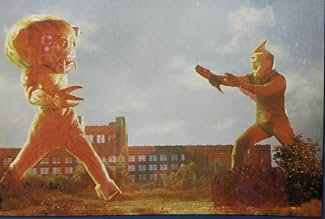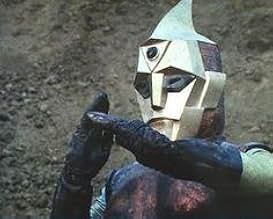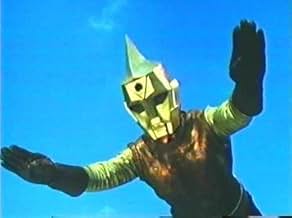Enviado por la Estrella Nebulosa para defender la Tierra, un supercyborg lucha contra los monstruos mutantes de la contaminación creados por los malvados simios espaciales Gori y Rah.Enviado por la Estrella Nebulosa para defender la Tierra, un supercyborg lucha contra los monstruos mutantes de la contaminación creados por los malvados simios espaciales Gori y Rah.Enviado por la Estrella Nebulosa para defender la Tierra, un supercyborg lucha contra los monstruos mutantes de la contaminación creados por los malvados simios espaciales Gori y Rah.
Explorar episodios
Opiniones destacadas
I really really liked this show growing up. the video store next to my house only had two episodes and i always used to rent them. I thought i was the only person outside of japan to see this show but now i know that there are others. I want to buy some videos or dvd of the shows if i ever find them. Hey if you bought a few videos dont be shy please let me know where you bought them.
Bizarre -- even by 70's Japanese "tokusatsu" (special effects series) standards, and highly entertaining. This series was produced in 1971 by P Productions, which in the mid-60's created Space Giants, a UHF TV staple of the 70's. Spectreman was, improbably, brought to US shores in 1979, eight years after its Japanese run, by Mell Welles, who was best known for his role as Gravis Mushnick in the original 1960 Little Shop of Horrors.
Like Space Giants, Spectreman would fight the same monster several times over the course of two episodes, presumably to save on monster suit costs. Also, like Space Giants, the series nemesis, Dr. Gori, was a space villain seeking to rule the earth (this time using giant "pollution monsters" as his tactic of choice) who operated from a flying saucer, wearing an exquisitely cheesy gorilla mask and blonde wig. No doubt this character was aped from Dr Zaius in Planet of the Apes, which was very popular in Japan. And, again, like Space Giants, optical effects were eschewed. Instead, P Productions used (and reused) animated sequences for transformations and various beam weapons to cut costs.
Unlike the many other transforming heroes of Japan, Spectreman was not in control of his transformation. He answers to his "overlords", an orb-like spaceship that he can't contact in cloudy weather. In some episodes he must drive to where there is no cloud cover to contact the overlords. Sometimes they will insist he transform. Sometimes he will request transformation, and will be denied. The overlords are positioned as wise overseers, similar to the "Methuselah" character in Space Giants, both of whom are prone to lecture the hero.
In re-watching the series, it seemed to get a bit of a budget boost around a 1/3 of the way into the series. The FX were incredibly threadbare in the first 10 or so episodes with most monster battles occurring in open fields. Then Spectreman started having battles in cities with building miniatures, creatures started to appear in oceans and lakes requiring access to a wet FX set, and fighter jet miniatures started being used, along with more pyrotechnics.
Overall, Spectreman is inspired early-70's Japanese cinema outre fun.
Like Space Giants, Spectreman would fight the same monster several times over the course of two episodes, presumably to save on monster suit costs. Also, like Space Giants, the series nemesis, Dr. Gori, was a space villain seeking to rule the earth (this time using giant "pollution monsters" as his tactic of choice) who operated from a flying saucer, wearing an exquisitely cheesy gorilla mask and blonde wig. No doubt this character was aped from Dr Zaius in Planet of the Apes, which was very popular in Japan. And, again, like Space Giants, optical effects were eschewed. Instead, P Productions used (and reused) animated sequences for transformations and various beam weapons to cut costs.
Unlike the many other transforming heroes of Japan, Spectreman was not in control of his transformation. He answers to his "overlords", an orb-like spaceship that he can't contact in cloudy weather. In some episodes he must drive to where there is no cloud cover to contact the overlords. Sometimes they will insist he transform. Sometimes he will request transformation, and will be denied. The overlords are positioned as wise overseers, similar to the "Methuselah" character in Space Giants, both of whom are prone to lecture the hero.
In re-watching the series, it seemed to get a bit of a budget boost around a 1/3 of the way into the series. The FX were incredibly threadbare in the first 10 or so episodes with most monster battles occurring in open fields. Then Spectreman started having battles in cities with building miniatures, creatures started to appear in oceans and lakes requiring access to a wet FX set, and fighter jet miniatures started being used, along with more pyrotechnics.
Overall, Spectreman is inspired early-70's Japanese cinema outre fun.
At first I really did not like this show; it took about 10 or 15 episodes for it to really grow on me though. Once it got going and the characters were established (other than the women, who switch every 15 episodes or so) it was actually really fun.
Some of the later episodes are actually better than a lot of regular "Ultraman" shows and near the last quarter of the series, it becomes a hybrid of "Kamen Rider" and "Ultraman" which is kinda cool to see.
Karras is easily one of the best villains in any of these shows so far and even though you can only watch the English dub now, it still holds up as one of the greats; knock-off or not.
Some of the later episodes are actually better than a lot of regular "Ultraman" shows and near the last quarter of the series, it becomes a hybrid of "Kamen Rider" and "Ultraman" which is kinda cool to see.
Karras is easily one of the best villains in any of these shows so far and even though you can only watch the English dub now, it still holds up as one of the greats; knock-off or not.
I have always liked this series. The hero Spectreman is so cool. The villains which are gorilla like but they are some time very funny. The monsters are neat and the action is very good. Back years ago it was somewhat easy to find videos of this good show but now its a different story. I really liked Spectreman and hopefully one day some company will re-release it soon!
I blind bought this series a few years ago from a bootleg seller on ebay. It wasn't much of a risk since Ultraman is one of the earliest show I remember watching and this is a pretty good knockoff. Oddly, I now find this show a slightly more entertaining watch than Ultraman. All the shows have a environmental theme and the creatures are often hilarious! I love how the female character changes often. It's like they keep upgrading her. Heh! But I can't recommend this enough to fans. I paid about $50 for it. That's a lot, but I wasn't disappointed. Maybe BCI will release this like they did Ultraman. If the quality is equal to that release, I'd upgrade my bootlegs in a minute.
¿Sabías que…?
- TriviaThe series was a reasonable success in Japan. When it came to the US received a good audience and the distributor changed the opening song. They made a new version using the song "The First Day of Forever" by the band The Mystic Moods Orchestra.
- ConexionesFeatured in The Creature Wasn't Nice (1981)
- Bandas sonorasSpectreman Go Go
("Supekutoruman Gô Gô")
(Main Title Theme, Episodes 1-39)
Composed & Arranged by Kunio Miyauchi
Lyrics by Yûji Amemiya
Sung by The Misuzu Children's Choir, The Honey Knights & Studio Orchestra
Selecciones populares
Inicia sesión para calificar y agrega a la lista de videos para obtener recomendaciones personalizadas
- How many seasons does Spectreman have?Con tecnología de Alexa
Detalles
- Color
Contribuir a esta página
Sugiere una edición o agrega el contenido que falta
























